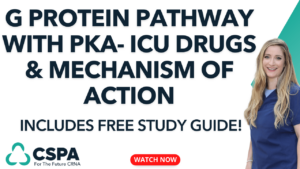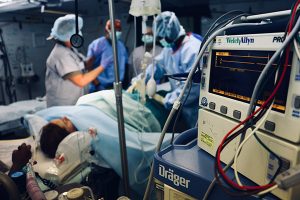
Get Your Free CRNA School Interview Prep Guide
Free CRNA School Interview Prep Guide Click Here
Mastering the complexities of the G Protein Pathway and deciphering the molecular mechanisms of PKA not only equips you to tackle challenging CRNA interview questions with confidence, but it also unveils a simplified understanding of ICU drugs. Welcome back to the second part of our series on G Protein-coupled Receptor Pathways! Today, your host Jenny Finnell takes you on an exciting and simplified journey into the intricate world of protein kinase A (PKA) and its fascinating involvement in critical care drugs. Buckle up because Jenny will be diving deep into the molecular level to uncover the mechanisms of action behind commonly used ICU drugs like epinephrine and norepinephrine. Get ready for a content-heavy episode as Jenny masterfully breaks down the complexities of PKA and its role in the G Protein Pathway. Join us in understanding how critical care drugs work and ace that CRNA interview!
Grab the FREE Study Notes for this episode here:https://www.cspaedu.com/ldmbjald
Thousands of nurses have gained CRNA school acceptance with CRNA School Prep Academy. Join today for access to all of the tools proven to accelerate your CRNA success! Click here:
https://crnaschoolprepacademy.com/join
Join the CSPA email list: https://www.cspaedu.com/podcast-email
Join the Free Facebook Community here! https://www.facebook.com/groups/crnaschoolprepacademyfree
Book a mock interview, resume or personal statement critique, transcript review and more: www.teachrn.com
—
Watch the episode here
Listen to the podcast here
G Protein Pathway Part #2 With PKA: ICU Drugs & Mechanism Of Action
This episode is going to be part two of the G Protein-Coupled Receptors Pathways, but we’re going to do something a little bit different. We’re going to go into the protein kinase A and its involvement. There’s going to be some overlap, but my hope is that by the time you’re done with this part two series, you’re going to have a better understanding of how critical care drugs such as epinephrine, norepinephrine, and things like that work down to the molecular level. These are very common interview questions that are asked in the CRNA interview. I hope that you take notes. If you missed Part One, please review it here.
Like the last time, we have a free resource for you to download. It might save your hand from cramping from taking so many notes because I will be going fast through this. It is going to be heavy, so just a fair warning. Again, I hope you guys enjoy it. Let’s go ahead and get into the show. As I said, we’re going to go into the protein kinase A. I want to explain that in a little bit more detail since we went into the G proteins last time. I know we touched on the PKA and its involvement. We’re also going to go into more of a deep dive into different medications and their mechanism of action.
In the study notes, we’re going to have all these medications and the mechanism of action listed out for you. We’re also going to have some additional medications listed out for you that are not necessarily involved in these pathways, but I feel like they’re important medications for you to know. I went ahead and included them. For this episode, we’re not going to discuss those medications. We’re only going to discuss the medications that cover the G protein and the PKA pathways.
Protein Kinase A – PKA
Protein Kinase A or PKA is a key enzyme in the Cyclic Adenosine Monophosphate, also known as cAMP, signaling pathway. It’s involved in multiple cellular processes, including the heart, where it regulates contractility, heart rate, and other functions. PKA acts through a signaling cascade that starts with the activation of a G Protein-Coupled Receptor, GPCR, on the south surface by a vasoactive or cardiac drug. For example, let’s talk about beta-adrenergic receptors. Receptor activation, a drug like a beta-adrenergic agonist like isoproterenol, for example, binds to the beta-adrenergic receptor, which is a type of G protein-coupled receptor on cardiac monocytes, so a cardiac cell.
You have the cAMP or the Cyclic Adenosine Monophosphate, cAMP production- to go into more detail on that, once it’s activated, the G protein-coupled receptor stimulates a G protein, which in turn activates adenylyl cyclase. This adenylyl cyclase catalyzes the conversion of ATP to cAMP. Again, that is the process of cAMP production.
If we go into PKA activation, we’re looking at high levels of cAMP, which activate PKA. Again, back to the production of cAMP, once you have high levels of cAMP, you then activate the protein kinase A. PKA is a tetramer composition, which is composed of two regulatory subunits and two catalytic subunits. cAMP binds with the regulatory subunits causing a conformational change that then releases the catalytic subunits. These catalytic subunits are the active form of PKA. They cause the reaction like a catalyst. Think of a catalyst. They actually caused the change to occur.
Now we’re going to talk a little bit about the phosphorylation of target proteins. Once active, PKA phosphorylates a variety of target proteins leading to changes in their activity, such as in the heart. These proteins include an L-type calcium channel and proteins involved in calcium handling and contraction. Things like troponin and then myosin-binding protein C cause the actual contraction to occur in the heart.
Let’s go into some cardiac effects that involve PKA and the G protein-coupled receptor scenario. The phosphorylation of these target proteins leads to their activation or inactivation, causing effects such as increased cardiac contractility or a positive inotrope, an increase in heart rate, a positive chronotrope, and faster relaxation. In terms of vasoactive drugs, PKA also plays a role in vascular smooth muscle relaxation.
For example, nitric oxide activates guanylate cyclase to produce cyclic GMP, which activates Protein Kinase G, PKG. PKG can then phosphorylate and activate myosin light chain phosphatase leading to dephosphorylation of the myosin light chain, causing muscle relaxation. While this is more about PKG than PKA, I wanted to highlight how kinase enzymes are crucial in signal transduction, pathways involved in the cardiovascular system, and different types of pharmacology. Remember that while these are common pathways, the specific effect can vary based on the tissue type and the specific receptor involved in specific downstream targets of the PKA reaction.
Vasopressin
The first drug we’re going to go into is vasopressin. Vasopressin, also known as ADH or Antidiuretic Hormone, primarily acts on the V2 receptors in the renal collecting ducts. Activation of the G protein-coupled receptors stimulates adenylate cyclase increasing cAMP. Does that sound familiar from what we went over a few moments ago? It then activates the PKA.
PKA phosphorylates proteins in the cell leading to the insertion of water channels, also known as aquaporin-2, into the apical membrane of the collecting ducts in the kidneys. This increases the permeability of the cells to water, which promotes water reabsorption and, thus, antidiuresis. Vasopressin also acts on the V1 receptor in the vascular smooth muscle cells, causing vasoconstriction. This is a very nice summary in a pretty concise way of how vasopressin works down to the molecular level.
My hope is that the more you know it and the more you understand it, the easier it’s going to get to have an understanding of the mechanism of action of these drugs. Next, we’re going to go into phenylephrine, also called Neo-S for short. Often, you will hear that it’s anesthesia’s favorite drug because it is. We pretty much use it very frequently, especially in adult surgeries. Not so much in pediatric surgeries but there is a time and place for it.
Phenylephrine, also called neo, is known as anesthesia's favorite drug because it is used very frequently, especially in adult surgeries. Share on XPhenylephrine
Let’s get into phenylephrine. The alpha-1 receptor is a G protein-coupled receptor. Its activation stimulates the phospholipase C, which cleaves or essentially forms and makes Phosphatidylinositol, PIP, IP3, Inositol Trisphosphate, and Diacylglycerol, DAG. The IP3 triggers the release of calcium from the endoplasmic reticulum. A little flashback from anatomy pathophysiology in nursing school, I think. DAG activates the protein kinase C. This leads to the activation of myosin light chain kinase, also a repeat from earlier, and increased interaction between actin and myosin, causing vasoconstriction.
Phenylephrine is often used for vasoconstrictive effects. It can also be used as a nasal decongestant due to vasoconstrictive effects. Again, you can use something called Afrin for nasal intubations. You would always put that down the nasal passages first prior to sticking a giant tube down there because getting nosebleeds is no fun. That summarizes phenylephrine.

G Protein Pathway: Phenylephrine is often used for vasoconstrictive effects.
Epinephrine and Norepinephrine
Now, let’s get into epinephrine and norepinephrine. I combine these two because they work on very similar pathways and receptors other than epinephrine. It obviously hit them all where norepinephrine has more limitations. Hopefully, you guys don’t mind me summarizing these together. Both of these catecholamines act on adrenergic receptors.
Epinephrine acts on alpha-1, alpha-2, beta-1, beta-2, and beta-3. It acts on all of them. Epi, again, is the big gun. It affects them all. It depends on the dose. The effects on these adrenergic receptors depend on the dose of epinephrine given, where norepinephrine acts on alpha-1, alpha-2, and beta-1 receptors. You were missing the beta-2 and beta-3 from the norepinephrine. Their effects vary based on which receptor subtype they act on and which tissue. Receptor subtype act on is dose-dependent.
For example, activation of beta-1 receptors in the heart increases the adenylyl cyclase activity leading to increased cAMP and PKA activation, enhancing cardiac contractility and heart rate, so inotropic and chronotropic. In contrast, alpha-1 receptor activation, such as in phenylephrine or Neo, which activates in the smooth muscle, causes vasoconstriction. As you can see, the pathways are very similar. It depends on the dose and what receptor you’re actually affecting based on that dose as far as the results you get and the type of physiological effects you’ll see.
Dopamine
Now, we’re going to go into dopamine. Dopamine can act on D1, D5, D2, D3, D4 receptors as well as beta-1 and alpha-1 at high doses. At low doses, it primarily acts on D1 like receptors in the kidneys, heart, and blood vessels, causing vasodilation. I don’t know how often dopamine is used anymore in the ICU. I remember them using it quite often.
I think dobutamine is probably more common. I could be misspeaking but I feel like they’ve moved away from dopamine. I frequently remember doing renal-dose dopamine back in my NICU days for patients who were septic and things of that nature. I don’t know how often it’s used for that anymore. I think there’s a lot of literature out there that doesn’t state much of a clinical significance to do that type of dosing. Nonetheless, that is how D1 receptors work in the kidneys, hearts, and blood vessels, causing vasodilation.
At moderate doses, it acts on the beta-1 adrenergic receptors, increasing heart rate in contractility. At high doses, it acts on alpha-1 adrenergic receptors causing vasoconstriction. The D1 like receptor activation stimulates adenylyl cyclase and increases cAMP production leading to PKA activation and then downstream effects.
I don’t know if you guys ever noticed this recurring theme that most of these receptors activate or stimulate adenylyl cyclase, which then forms cAMP, leading to PKA, which then causes the effect. If you took anything from this episode, I would write this down. It’s the same pathway for cause and effect in almost all of these drugs, which is when you activate that receptor, it stimulates or activates adenylyl cyclase, which then increases cAMP production leading to PKA activation and then downstream effects.
I think that’s really one of the key takeaways from this lecture and the mechanism of action of these drugs. Depending on what actual receptor they’re affecting, you then know what that reaction is, whether that’s beta-1, alpha-1, or things of that nature. You would then have what that downstream effect actually is from this chain reaction.
Adenosine
Adenosine is the next drug. I should say adenosine primarily acts on alpha-1 receptors, which are inhibitory G protein-coupled receptors. It’s a little bit different than what we’ve covered before. This is inhibitory. It acts on alpha-1 receptors but it’s inhibitory on the G protein-coupled receptors. The activation of the alpha-1 receptors opens potassium channels and inhibits calcium channels leading to hyperpolarization of the cell and slowing the AV nodal conduction. This mechanism is why adenosine is used to manage SVT. It’s a little bit different type of pathway, but I wanted to at least show you something different than what we covered. It’s something that inhibits the pathway and what the cause of the inhibitory effects are on alpha-1 receptors.
Dobutamine
Last, we’re going to cover dobutamine. Dobutamine is a synthetic catecholamine that primarily acts on beta-1 adrenergic receptors. Although it also has some activity at beta-2 and alpha-1 receptors, the beta-1 adrenergic receptors are predominantly found in the heart and their activation leads to a cascade of events. These receptors are G protein-coupled and their stimulation activates adenylyl cyclase. That pathway adenylyl cyclase converts ATP to cAMP, which then turns and activates Protein Kinase A, PKA.
PKA then phosphorylates various proteins leading to increased calcium influx into cardiac monocytes. This enhanced calcium entry leads to a stronger contractile force, a positive inotrope, and then increases the heart rate or a positive chronotropic. Because we are affecting the beta-1, we are now looking at enhanced calcium entry, which therefore enhances the inotropic and chronotropic effect of this drug. The process leading to that is the same because it affected beta-1. It is why we started talking about calcium, inotropic, and chronotropic.

G Protein Pathway: The G protein-coupled receptor stimulation activates a donate cyclase. This enzyme converts a TP to stick click ANP, activating PKA or protein kinase. A PKA then phosphorylates various proteins leading to increased calcium influx into cardiac monocytes. This enhanced calcium entry leads to a stronger contractile force, a positive inotrope, and then increases the heart rate or a positive chronotrope.
The process that got them there is exactly the same as some of these other drugs, which is that the adenylyl cyclase converts ATP to cAMP, which, in turn, activates Protein Kinase A, PKA. Again, very important to remember that sentence right there. After you’ve memorized that sentence, you then say, “What receptor am I affecting?” From there, you can figure out whether it’s vasoconstriction, inotropic, chronotropic, and so on. I hope it simplifies the mechanism of action of a lot of these vasoactive drugs or ICU drugs for you.
I didn’t finish the dobutamine I apologize. To finish up and summarize, dobutamine is often used in cases of acute heart failure or shock. It also can increase cardiac output by increasing the force of the heart muscle contractions and the rate of contractions. It does have some activity at the alpha-1 receptor, which could potentially cause vasoconstriction. However, its main effects are typically inotropic and chronotropic due to its selectivity of the beta-1 receptor. Its beta-2 activity can lead to some vasodilatation, which can lower systemic vascular resistance and thus decrease the afterload against what the heart is then pumping, further increasing cardiac output.
Dobutamine is often used in cases of acute heart failure or shock. It can also increase cardiac output by increasing the force of the heart, the force of the heart muscle contractions, and the rate of contractions. Share on XIt does two things. It increases inotropic and slightly lowers the systemic vascular resistance, which decreases afterload and allows that increased contractility to pump against a more wide open tube. I always think of veins and arteries as tubes like big and little tubes. The afterload is what you’re pumping against as far as what it’s sending out the aorta and things of that nature. It definitely helps both ways. That summarizes the drugs that we’re going to cover. If you do grab the free printout, I also have amiodarone, atropine, and lidocaine on there, as well as additional drugs that I feel you should know that you may commonly see in the ICU and would be fair game in this CRNA interview.
I hope you guys enjoyed this summary. I know these are complex episodes. I’m hoping I helped simplify it and make it seem less scary to you. It comes down to a relatively simple pathway. If you remember that pathway as far as the basic pathway that leads to the downstream effects, the only thing you have to ask yourself is, what receptor are we affecting? From there, you can gather what the effects are going to be. Thank you, guys, so very much. I will see you guys next week. Take care.
Important Links
- Free Episode Study Guide: https://www.cspaedu.com/ldmbjald
Thousands of nurses have gained CRNA school acceptance with CRNA School Prep Academy. Join today for access to all of the tools proven to accelerate your CRNA success! Click here:
https://crnaschoolprepacademy.com/join
Join the CSPA email list: https://www.cspaedu.com/podcast-email
Join the Free Facebook Community here! https://www.facebook.com/groups/crnaschoolprepacademyfree
Book a mock interview, resume or personal statement critique, transcript review and more: www.teachrn.com









